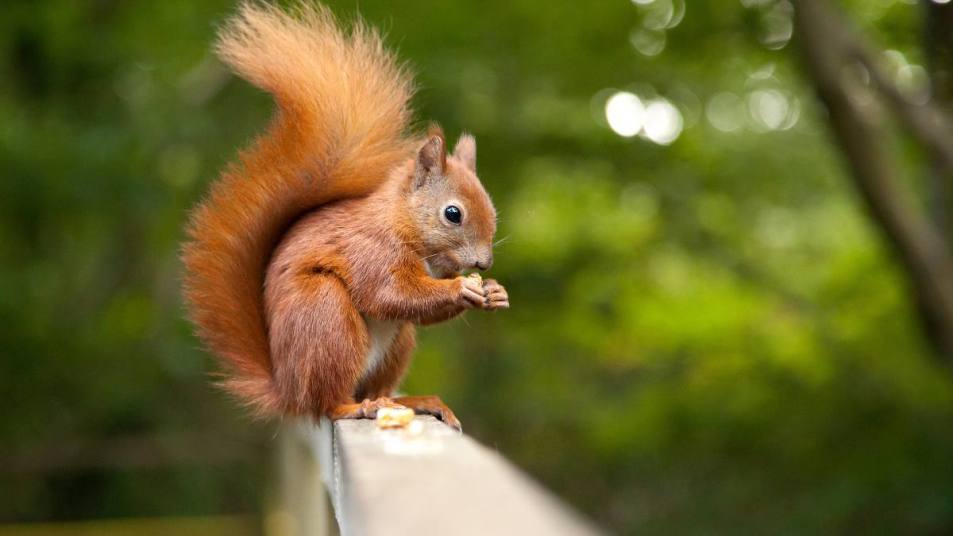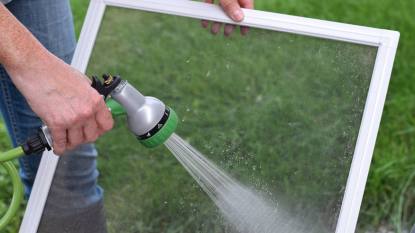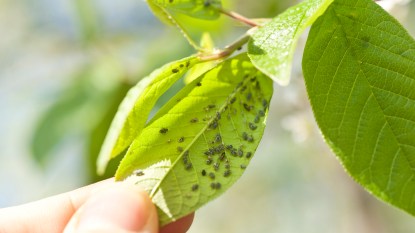9 Smart Ways to Keep Squirrels Away From Your Garden, According to Pest Pros
Plus, how to keep them out of your home too!

Sure, they’re cute and can make us laugh with their acrobatic antics, but squirrels are a menace to both our gardens and our homes. The United States is home to 65 different species of squirrel — only one state (Hawaii) is squirrel-free! And according to experts, squirrels cause thousands of house fires each year and cost millions in repairs for homeowners across the country. “They’re advertised as a dumb animal, but squirrels are actually both smart and persistent,” says Dan Schwarzbeck, owner of got wildlife?, a wildlife management company serving New York, New Jersey and Connecticut. But taking certain preventative measures can help protect your garden and property. Use these expert tips for how to keep squirrels away.
Why do squirrels come around?
Whether it’s placing bird feeders outside, neglecting to keep track of our homes or tempting them with juicy fruits and vegetables or fat flower bulbs, “we tend to enable wildlife,” says Schwarzbeck. So they invade our yards in the hopes of filling their bellies and staying warm and dry from the cold by getting inside.
How to keep squirrels away from your garden
1. Squirrel-proof your bird feeders
Squirrels are notorious climbers and jumpers, so if you plan to keep a bird feeder in your yard, it’s important that it’s located where squirrels won’t use it to access either your garden or your house — and it should be squirrel proofed, so they can’t climb the feeder and so any seeds that fall out don’t attract squirrels to your yard.
And while eliminating bird feeders works best, says Paul Curtis, Professor of Wildlife Science at Cornell University, there are a few other things you can do if you’re determined to feed the birds. “It is possible to squirrel-proof feeders on tall poles using baffles to prevent the squirrels from climbing,” he says. And because birds are messy eaters and spilled seed can attract both squirrels and other rodents, “you should have a catch basin of some type attached to the pole above the baffle to catch spilled seed.” (Click through for more ways to keep squirrels out of bird feeders.)
See this video from the Forest Preserve District of Will County, Illinois, on how baffles work to keep squirrels away
2. Install fencing
With a smorgasbord of seeds, plants, fruits and vegetables, gardens are hard to protect from squirrels! And while netting can help to protect fruits and vegetables, “squirrels are excellent climbers and will go right over a fence so you may have to completely enclose your garden with chicken wire,” says Sheldon Owen, Wildlife Specialist at West Virginia University Extension, who notes that this “is prohibitive on larger gardens.” Try burying the fencing in the ground, so the pesky critters won’t dig under it, and if you can’t completely enclose your garden, make the fencing high enough that they’re unlikely to climb it. Caging individual plants is also an option.
See this video from The How Do Gardener on fencing a garden:
3. Place your plants here
Squirrels will also take advantage of places to hide in order to access your garden and steal away with your fruits, vegetables, seeds and even flower bulbs. That’s why experts recommend proper placement of garden beds. And while it’s not guaranteed to deter a determined squirrel 100 percent of the time, good placement can help. “Placing your garden away from trees or brush will also reduce the likelihood of squirrel damage,” says Owen.
4. Pick promptly and clean up rotting fruits and vegetables
Squirrels may be attracted to overripe produce that falls to the ground and sits there rotting, say the folks at Colonial Pest, a pest control company in Massachusetts and New Hampshire. That’s why it’s important to pick fruits and vegetables as soon as they’re ripe rather than letting them over-ripen and fall to the ground, where they rot and attract squirrels and other nuisance animals.
5. Try a squirrel repellant
While squirrel repellants aren’t guaranteed to work and in fact aren’t the best way to protect your garden (or your house) because none will consistently deter squirrels, they do at least help to keep them away. “There are a few EPA-registered repellents containing capsaicin (ingredient that makes peppers hot) that could provide short-term relief from damage depending on the situation,” says Curtis. Just be aware that these would have to be reapplied on a regular basis, and are likely the least effective treatment for keeping squirrels away. Other repelling measures like sprinklers or plastic owls are typically also temporary deterrents and will lose effectiveness once the squirrels figure out how to get around them.
See this video from Backyard University on how cayenne pepper works to repel squirrels and other animals:
6. Plant unappealing produce
While squirrels like many of the vegetables, fruit and flowers we plant, there are some that are naturally unappealing. These include hot peppers, garlic, onions and certain types of flowers. According to the folks at Terminix, “Alliums in the form of flowers or garlic, scallions and onions produce a strong odor that squirrels may avoid.” The flowers on this list include Daffodils, Fritillaries, Hyacinth, Galanthus, Lily of the Valley and Geraniums. Other experts note that hot peppers will also help to keep them away. But the pros note that these also won’t be 100 percent effective — as squirrels are quite adaptable by nature. Try hanging baskets of these unappealing flowers around the perimeter of your garden and planting onions, scallions, garlic and hot peppers around the exterior to help keep them away.
How to keep squirrels away from and out of your home
1. Keep up with home maintenance
“Aging construction is a big opportunity for squirrels to rip into a house,” says Schwarzbeck. Squirrels come inside for safety, comfort and breeding, he says, and once they’re in, they can create structural damage and cause fire hazards with chewed wiring. Schwarzbeck recommends walking around outside and “looking up” at your house to determine if there are any gaps or open soffits the opportunistic animals can use to sneak inside — and then closing up any open soffits, replacing plastic gable vents and just generally filling any openings big enough for a squirrel to use. Also be sure to keep chimneys capped — since these can also be an entry avenue for the animals.
See this Youtube video from Mr. Happy House on how to make home repairs that will prevent squirrels from coming into your home:
2. Get a pet
Having a pet like a cat or dog may also deter squirrels from coming into your home or yard, says Owen. “Having a cat or dog that will chase squirrels can help,” he notes, but it’s not a full-proof method for keeping them away. “In most cases the squirrels are in the trees or attic out of reach of our pets.”
3. Keep trees trimmed
The eastern tree squirrel, the most commonly seen squirrel in the United States, is a great acrobat and can jump anywhere from 3 to 5 feet high and 8 to 10 feet across. “Tree limbs overhanging the roof provide squirrels with easy access to the attic area,” says Curtis. And since we already know that squirrels will seek out warm shelter (in addition to food), it’s important to keep trees trimmed to a distance from your home that will deter them from jumping to your roof and gaining access to your attic through vents, soffits and other openings. Wrapping tree trunks in aluminum or another slippery material that won’t allow squirrels to climb them can also be helpful in keeping them away. Some companies even sell tree baffles made out of smooth, heavy duty plastic.
See this video from Frontline Animal Removal on keeping trees trimmed:
For more pest removal tips, click through the links below!
The Genius Castor Oil Spray That Keeps Moles From Ruining Your Lawn and Garden
10 Easy Ways To Keep Deer Away From Your Garden Without A Fence
The One *Food* That Will Keep Raccoons Away From Your Trash Can – Plus 9 Other Things They Detest













